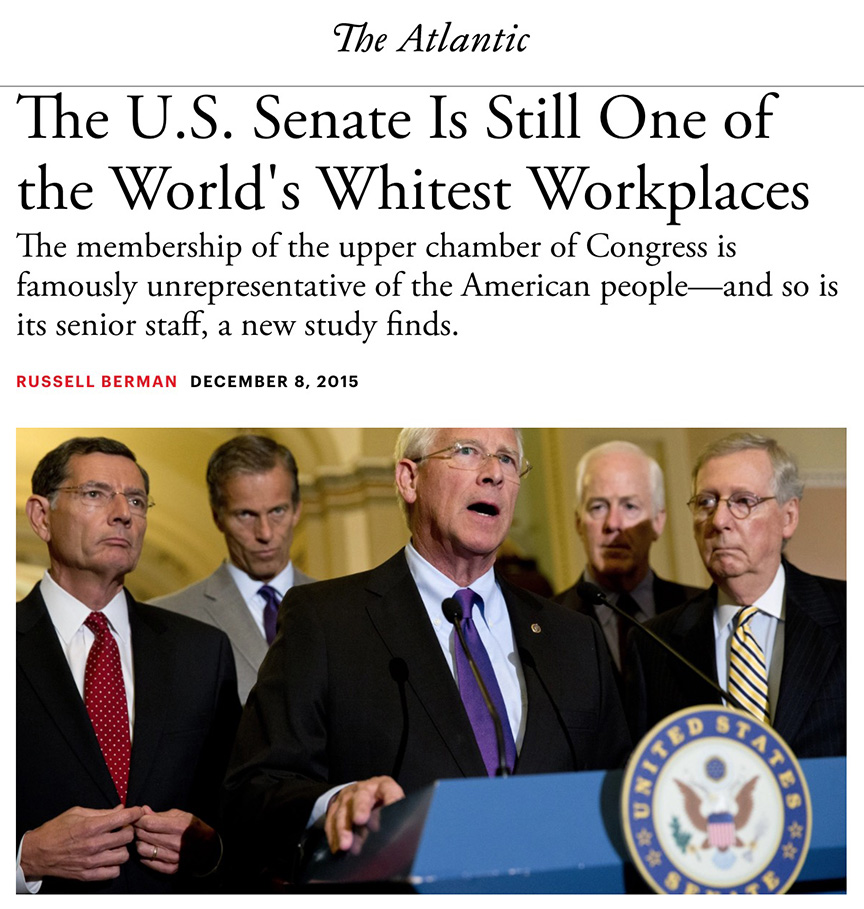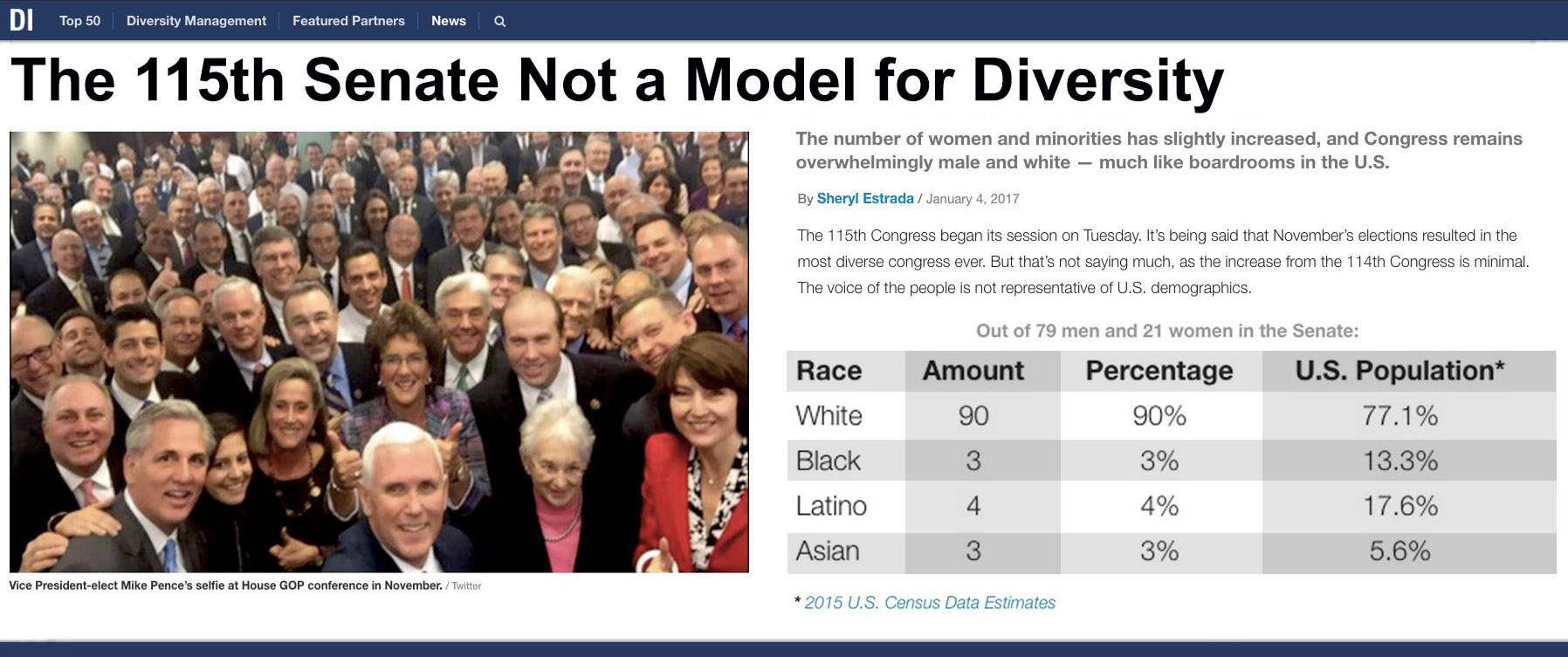DRAFT
The Senate Problem
There is no legislature in the world with an institutional framework more beneficial to minorities than the US Senate. The trouble is, because of the peculiar (and grossly unfair) way Senators are elected, the US Senate is almost entirely devoid of minorities (both political and racial). This can be remedied perfectly and democratically employing a solution that has been understood for over a hundred years.
Unfortunately, fixing this issue with the Senate requires a change to the Constitution. And so while we consider it vitally important, we focus more of our energy on another, perhaps equally important fix for Congress (the problem of committee transparency) as this can be fixed with a simple rules change in the House.
James D’Angelo & Ronald Nsubuga – Upcoming Paper 2021
Many observers have argued that the Senate is what senators want it to be. A deliberative body that protects the rights of minorities.Steven Smith 2005 – Parties and Leadership in the Senate
The U.S. Senate is the most unrepresentative upper house in the world.Fareed Zakaria 2003 – Future of Freedom
Nearly unique among the world’s national legislative bodies, the United States Senate allows a minority of its members to prevent a vote on regular legislative business.Steven Smith 2005 – Parties and Leadership in the Senate
Racial minority groups should get fair representation. A state like Georgia that’s 30 percent black shouldn’t have an all-white congressional delegation.Matthew Yglesias 2017 – The real fix is proportional representation
The U.S. Senate is famously known as the world’s most deliberative body, but it has never been its most representative.Russell Berman 2015 – Senate Is One of the Whitest Workplaces
The US Senate is the only organization in the US federal government that expressly favors minority groups. It is alo is one of the only minority-biased legislatures in the world. In the US Senate, minority power is so extreme that even individual rank-and-file members have weapons not just to take on the rest of the chamber, but to tackle abuses anywhere on Earth. This extreme power given to minority members is not found in the House and certainly doesn’t apply to the executive branch or the Supreme Court.
Thus, it would seem that the US Senate would be the focal point for both racial and political minorities seeking to protect their rights and establish justice. Afterall, it holds the key to the US Federal justice system (the Senate confirms all federal justices).
But it is not.
This is because the Senate (unlike the general population) is almost all white and always has been. And due to a concession made by the non-slave states during the writing of the Constitution (known as the Great Compromise), the US Senate has remained one of the whitest organizations inside or outside of government. Indeed, at 90% white, the US Senate ranks up there with vetenarians and sheet metal workers as one of the most racially elitist jobs in the US. This means that Senators like Elizabeth Warren and Bernie Sanders have accepted a post that is biased by a powerful form of affirmative action – that overwhelmingly benefits whites. Yet neither of these ultra-liberal Senators has ever discussed the issue.

Russell Berman 2015 - Atlantic Magazine

Russell Berman 2015 - Atlantic Magazine

Russell Berman 2015 - Atlantic Magazine

Russell Berman 2015 - Atlantic Magazine
Contrary to what numerous pundits claim about the quality of minority candidates (who often run better campaigns than whites) or financial inequalities, this racial disparity in the Senate has nothing to do with PACs, political skill or money. Instead it is simply a problem of math – indeed, a mistake with how we vote for Senators – that creates this overtly majority based institution.
Surprisingly, there is a well known solution (called proportional representation) that solves this problem perfectly and democratically, employing ideas that have been understood for over a hundred years. Further, proportional representation (PR) is the only known, agreed upon solution to gerrymandering. But because of its implications for favoring minorities over those of supposed states rights, the discussion on proportional representation with respect to gerrymandering continues as if without a solution. And it means therefore that the discussion of gerrymandering itself is a race-fueled discussion pitting those in small states (overwhelmingly white) with those elsewhere.
Video
Our video covers Proportional Representation and the Senate Problem in full detail

James D’Angelo 2015 – Solving the Senate

James D’Angelo 2015 – Solving the Senate
A Powerful Cure for Institutional Racism
The greatest care should be employed in constituting this Representative Assembly. It should be in miniature, an exact portrait of the people at large. It should think, feel, reason, and act like them.– John Adams 1776 – Thoughts on Government
Extend the sphere (increasing the diversity in Congress), and you take in a greater variety of parties and interests; you make it less probable that a majority of the whole will have a common motive to invade the rights of other citizens (corruption is less probable).– Madison 1787 – Federalist Papers N. 10
The practice [of holds] probably emerged from features long associated with the Senate, such as its emphasis on minority and individual interests...and a legislative culture that encourages accommodation for individual Senators’ policy and personal goals.– Oleszek 2007 – Proposal to Reform
The filibuster, or threatened filibuster, is what provides the ultimate protection for extended debate and the preservation of individual and minority rights.– Smith 2005 – Parties and Leadership in the Senate
It’s hard to imagine, not just a cure for institutional racism, but a set of procedures that bend over backwards to better the conditions of minorities. But that is precisely the institutional framework of the US Senate.
What if the cause for gerrymandering and institutionalized racism is also a source for massive corruption and partisanship? More importantly what if all three problems can be fixed simply, perfectly and democratically? That is the focus of this investigation, which dives into a seemingly tiny compromise the Founding Fathers made in 1789 involving the most powerful special interest of the day - slavery.
Unlike the House of Representatives or Parliaments in Europe, the US Senate often relies on unanimous consent agreements (UCAs), a procedure that gives veto power to each individual member of the Senate. Like the name implies, a UCA means that legislation can be (and often is) derailed by the wishes of just one member. And a rogue Senator’s ‘hold’ can create pressure on the actions and decisions not just of the Senate, but also the House and the Executive Branch.
Minorities benefit in the Senate in other ways as well. The Senate requires a super-majority (60-40 split) for the passage of many of their of their votes. This means that the minority (or a coallition of minority members) now need to muster only 40 votes (not 50) to force the majority to bargain. And, most famously, the Senate has the filibuster, which allows a single Senator to hold the floor for extended periods of time to push their agenda. Once again, this means that a lone Senator (or just a handful of members) can throw a wrench into the design and passage of any bill. Compare this to the House where single congressmen (or even large groups of minority members) are all but powerless.
Individual Senators can also conduct investigations.
Individual legislators, factions, and the minority party carry greater weight on the Senate floor than on the House floor.– Smith 2005 – Parties and Leadership in the Senate
This is why the most famous Senators aren’t just the leaders (as in the case of the House) but also the rogues. John McCain, Bernie Sanders and Rand Paul are famous because they are mavericks, often holding unique positions, which pressures not just the Senate, but all US legislation.
Our Justice System Relies on the Senate

Sheryl Estrada 2017 - 115th Congress Not a Model for Diversity

Sheryl Estrada 2017 - 115th Congress Not a Model for Diversity
Congress remains overwhelmingly male and white — much like boardrooms in the U.S.– Sheryl Estrada 2017 – 115th Congress Not a Model for Diversity
The US Senate doesn’t just confirm the members of the Supreme Court and other important federal courts, it also has the power to assert a vast amount of its own brand of justice. Indeed, one of the central functions of the Senate is to watch the watchmen. Oversight hearings and other congressional actions are the primary and most powerful check on the abuse of police, executive power or injustice. As such, any mention of the terms ‘institutional corruption,’ ‘police brutality,’ or ‘injustice’ should require a review of why or why the Senate might not be is doing its job.
States Rights vs Civil Rights
The trouble is, the US Senate is one of the least diverse institutions in government, and even one of the least diverse institutions anywhere. The numbers are grim. While the nation has well over 35% minority citizens (13% black, 19% latino, 6% asian), the Senate is always well over 90% white. But, this should not be taken as a slight to minority candidates. Indeed, the Senate's racial (and political) uniformity is assured via a mistaken approach to voting which we now understand (called single-member districts). And the solution (multi-member districts) has been applied successfully in other countries, and provides a significantly more representative institution immediately. Shockingly, the data suggests that minorities, given equal treatment via voting, prove to be more successful candidates than whites.
Indeed in a time with so much racial turmoil, it is mystifying how the Senate receives a free pass from the media. The Senate (unlike the House) has the keys to not just to the Supreme Court but dozens of other courts and justices throughout the nation. In shorty, they determine what type of justice exists in the USA. But because of a simple mathematical mistake the founders unwittingly made 250 years ago, the Senate has perpetuated inequality, illegitimacy and likely even racism. It is a mistake that needs to be fixed.
Those who support efforts at limiting gerrymandering are often white-machine liberals. And this is for good reason. Despite all the talk about gerrymandering, the US Senate (and not the House) is the government's least representative (diverse) body by a wide margin. This is especially peculiar because the Senate cannot be gerrymandered. The electoral borders between the USA's 50 individual states are not up for simple negotiation. Still, the US Senate is significantly less diverse, not just compared to the House, but also to nearly any other institution or private industry in the US.
Other Notes
"Proportional representation is the principle that a legislature should reflect all of the voters who elect them. Like-minded voters should be able to elect representatives in proportion to their number. In contrast, most elections in the United States are winner-take-all: instead of reflecting all voters, our legislators reflect only the biggest or strongest group of voters that elected them, leaving all others unrepresented. The use of winner-take-all voting methods in our elections for state legislatures and Congress is a central reason for major problems with our politics: gerrymandering, partisan gridlock, no-choice elections and distortions in fair representation all have roots in the inherent problems of winner-take-all methods." - FairVote
Multi-member districts (MMDs) are electoral districts that send two or more members to a legislative chamber. Ten U.S. states have at least one legislative chamber with MMDs - A multi-member electoral district (MMD) is an electoral district electing more than one representative to office. All proportional representation systems use MMDs, simply because it is impossible to distribute anything proportionally if there is only one seat. In proportional systems, the simple rule is that the larger the district size the more proportional the system. Other systems using MMDs are Block Vote, Party Block Vote, Mixed Member Proportional systems and Parallel systems.
Multi-member Super District Voting in the House of Representatives would eliminate gerrymandering entirely.
UPDATE (September 18, 2020)
The lone reason we don’t pursue this line of work further is because of how difficult it would be to accomplish change. It would require a Constitutional amendment. This is why we focus on our work on the pitfalls of transparency which is not only supported by the constitution, but one where a reversal of the 1970 legislation that opened up the system can be reversed by a simple congressional rules change. Like the Senate problem we forsee that a reversal of the 1970s transaprency laws would overwhelmingly benefit the poor and lead to improvement on climate, incarceration and other issues.
UPDATE (2017)
Since posting this video James has partnered with Harvard Professor of Congress David King and author Brent Ranalli to further investigate these ideas. The results are even more striking and powerful than initially proposed in this video.
EDIT May 21, 2016: Since I posted this video this problem becomes even more salient. This is because the US Senate is actually better equipped to serve minorities than most institutions on Earth. While the House has NO protections for minorities, the Senate has many (UCAs, filibuster, 60-40 splits, etc). These are powerful tools that dramatically serve minorities (of all types both political and racial). We also select a number of our presidents from the ranks of the Senate, so the lack of minority representation effects everything else as well (Presidency and the Supreme Court).



